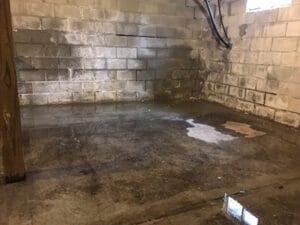Residential Basement Waterproofing Solutions
 Sump Pump Systems
Sump Pump Systems
Sump pumps are designed to eject water from around and below your foundation to the exterior and away from the foundation. When sump pumps fail or aren’t functioning properly they can lead to a variety of problem signs including foundation settlement, water on the floor, walls, and mold in your basement.
Sump pump system design – Sump pump systems should be designed by an engineer per the manufacturers ratings and recommendations and must be installed per their respective manufacturer’s recommendations, including the installation of a check valve to prevent backflow, installation of air relief valves, sump crock conditions, and with properly sized and oriented discharge piping.
Clogged or frozen discharge – Due to poor maintenance habits or an improperly designed drainage system, sump pump ejection pipes can become clogged or frozen, preventing discharge of the system. Sump pump discharge lines must be properly designed, installed, and maintained to prevent failure of the system.
Sump pump maintenance – Sump pump manufacturers generally recommend sump pumps be inspected every year for proper function and maintenance performed as necessary. The sump crock should be clear of debris and the discharge pipes should be inspected and cleared for proper flow. Sump pumps with battery back-up systems should have their batteries replaced every 2-3 years.
Perimeter Drain Systems
A perimeter drain is a French drain that is installed around the interior or exterior of a foundation that is designed to collect water and transfer the water to a sump pump system or gravity drain to a predetermined location away from the foundation. By collecting and removing the water away from the foundation, perimeter drains relieve the hydrostatic pressure from foundation walls and slabs.
Perimeter drains are generally used in conjunction with drain board, dimple board, or vapor barriers to ensure all water is properly collected and no moisture or vapor can evade the drain system.
French Drain Systems
A French drain, also known as a trench drain, blind drain, and drain tile, is a trench or void filled with gravel, rock, or other perforated pipe that redirects groundwater and surface water in the area to the desired location. French drains can be installed around the interior or exterior of a foundation or building to evacuate water from the location. French drains are sometimes used with sump pump systems when the drain cannot gravity drain naturally to a lower desired area. By collecting and removing the water away from the foundation, French drains to relieve the hydrostatic pressure from foundation walls and slabs.
French drains are generally used in conjunction with drain board, dimple board, or vapor barriers to ensure all water is properly collected and no moisture or vapor can evade the drain system.
French drains are generally used in conjunction with drain board, dimple board, or vapor barriers to ensure all water is properly collected and no moisture or vapor can evade the drain system.
 Sump Pump Systems
Sump Pump Systems